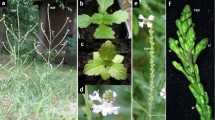Abstract.
Brassica oleracea L. is highly polymorphic and includes varieties which exhibit a headed phenotype (a large preinflorescence): the curd of cauliflower and `romanesco' (var. botrytis), and the spear of broccoli (var. italica). This headed phenotype results from highly iterative patterns of activity at the primary meristems. Differences in the morphology of curds and spears are accounted for by three quantitative variables: the rate of production of branch primordia on the flanks of the apical meristems (RPP); the number of branch primordia produced before the first formed begin producing their own branch primordia (the iteration interval, ITI); and the duration of the preinflorescence stage (before production of flower primordia). Relatively stable iteration parameters (RPP and ITI) during curd development lead to the production of semi-spherical curds with a smooth surface in cauliflower and broccoli, whereas in `romanesco' RPP and ITI increase throughout curd development, inducing a pyramidal curd with an angular surface. A relatively long preinflorescence stage in cauliflower and `romanesco' results in the curd surface being composed largely of branch primordia, whereas in broccoli this stage is short and the spear surface is made up of flower buds. Simplified growth models for these three headed types are presented. The implications for the genetic control of the B. oleracea L. headed phenotype and the relationships between shoot apical meristem size, phyllotaxis and curd/spear morphology are discussed.
Similar content being viewed by others
Author information
Authors and Affiliations
Additional information
Received: 11 September 1997 / Accepted: 12 November 1997
Rights and permissions
About this article
Cite this article
Kieffer, M., Fuller, M. & Jellings, A. Explaining curd and spear geometry in broccoli, cauliflower and `romanesco': quantitative variation in activity of primary meristems. Planta 206, 34–43 (1998). https://doi.org/10.1007/s004250050371
Issue Date:
DOI: https://doi.org/10.1007/s004250050371




